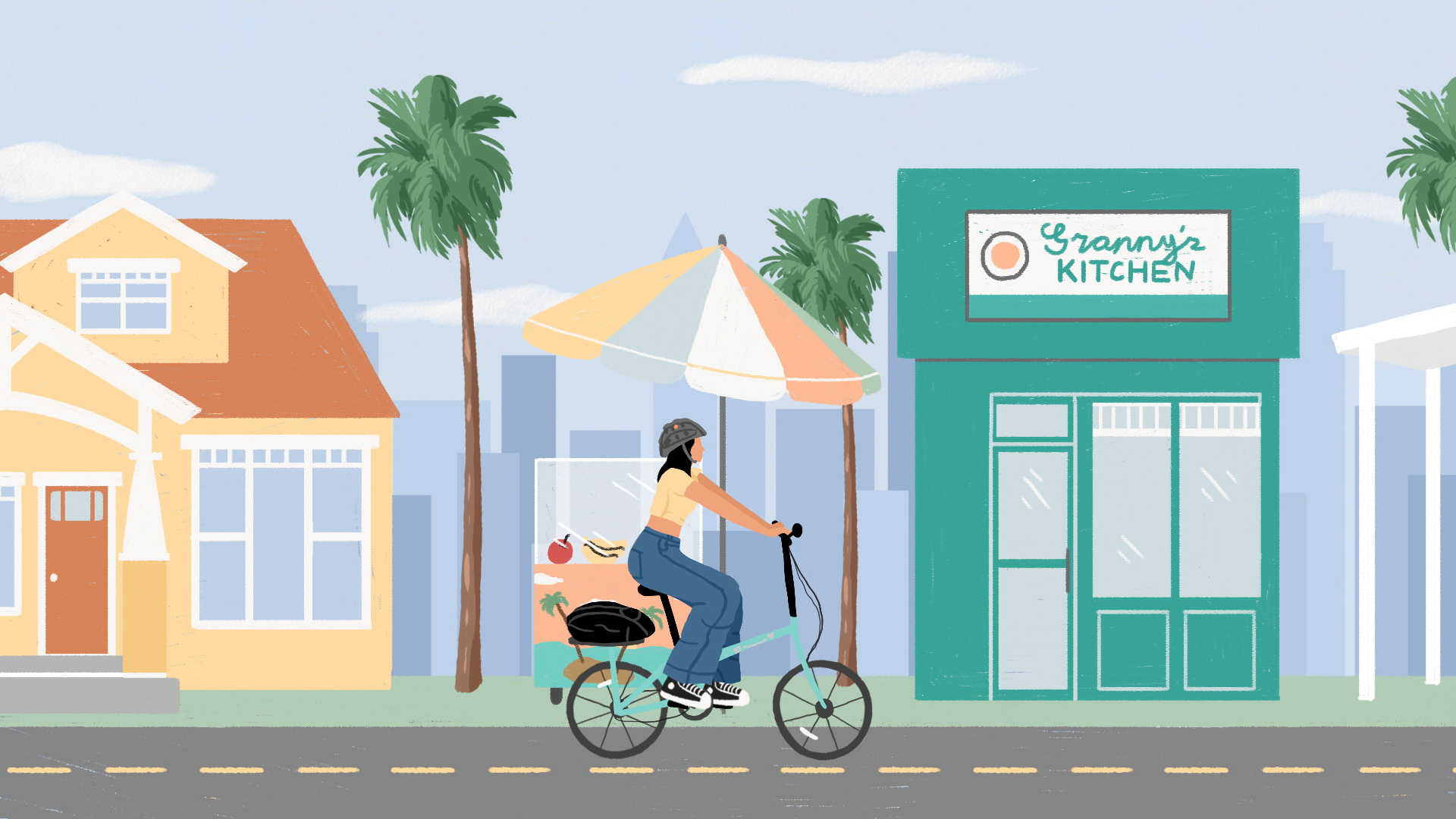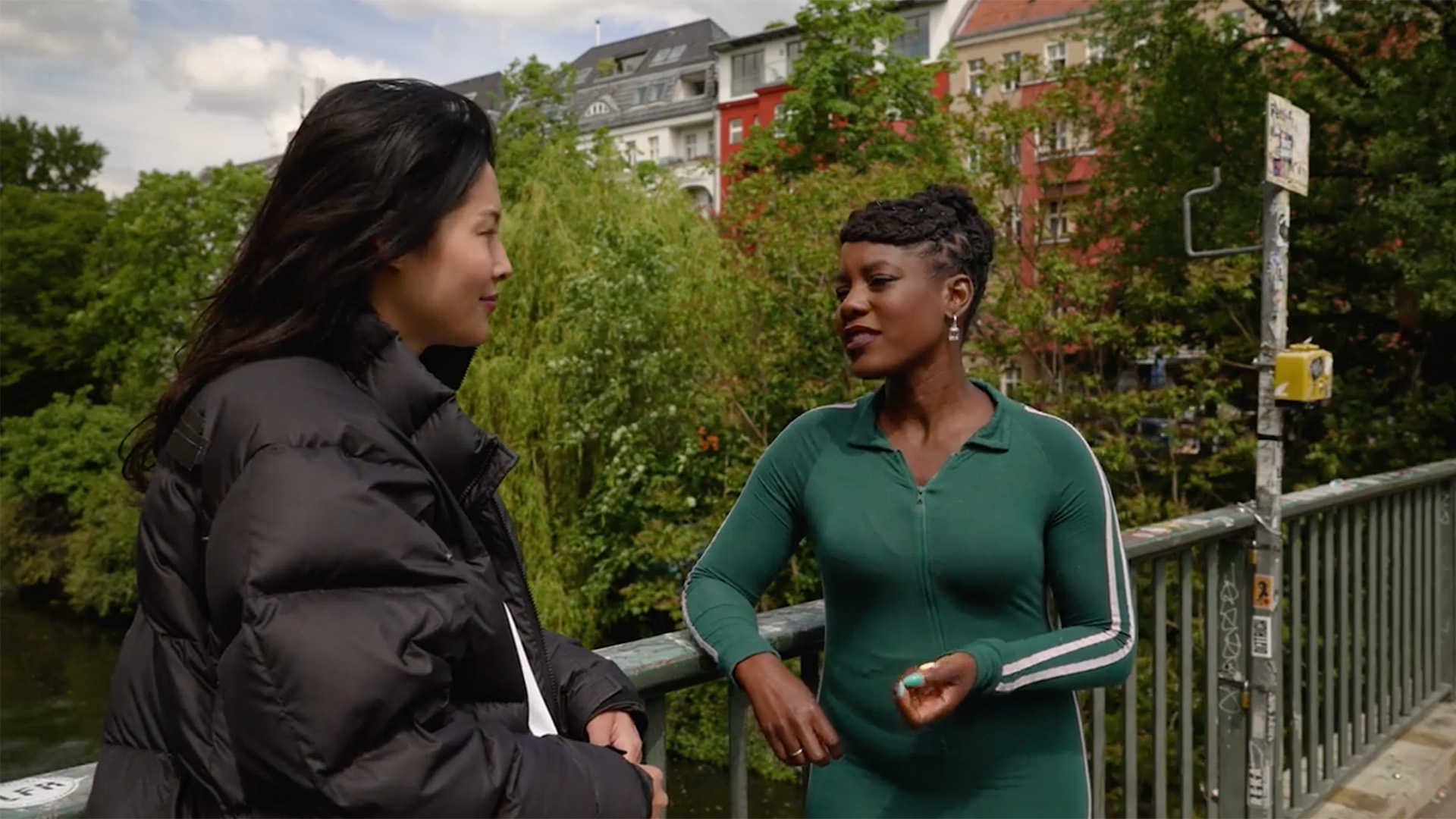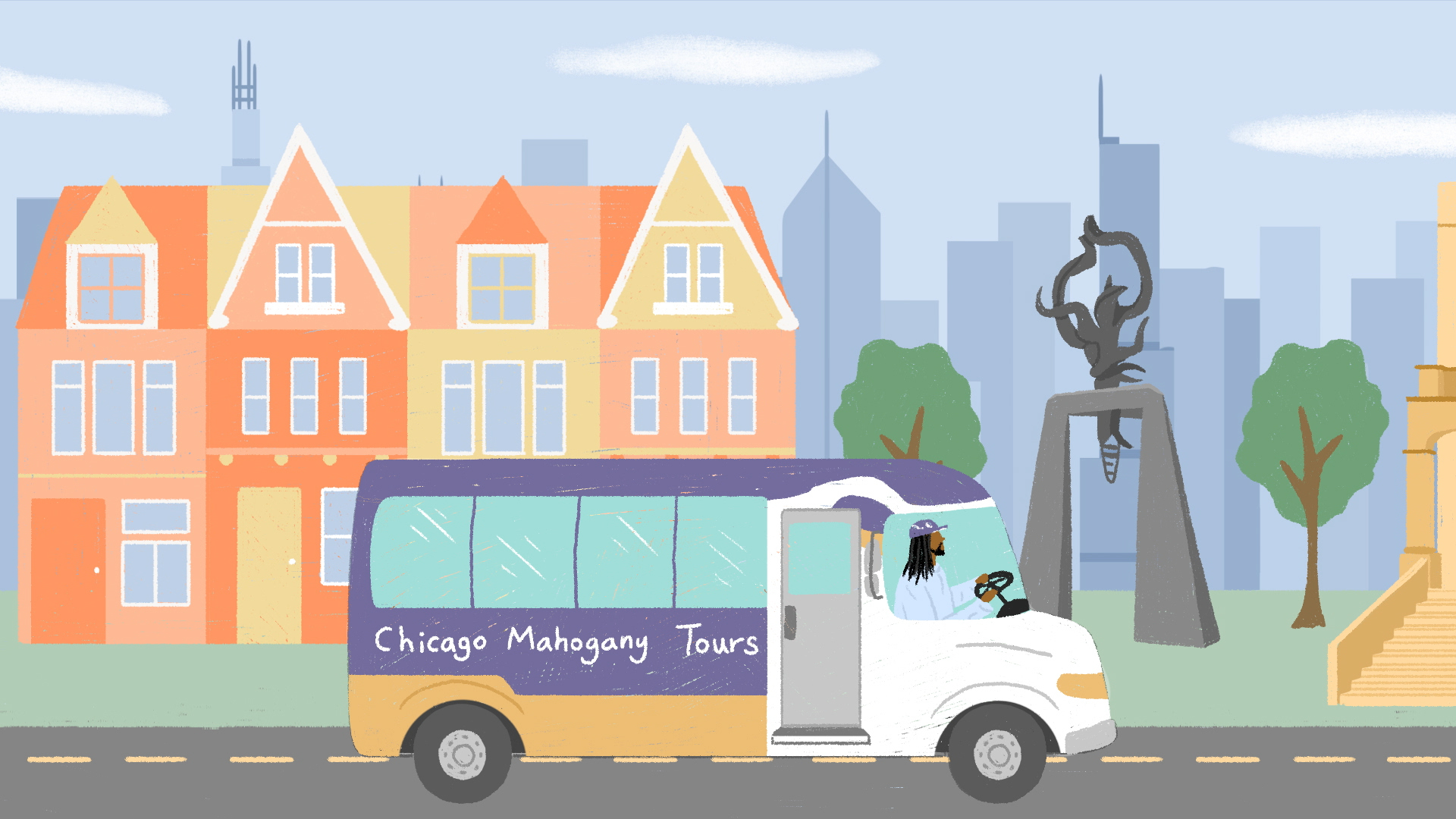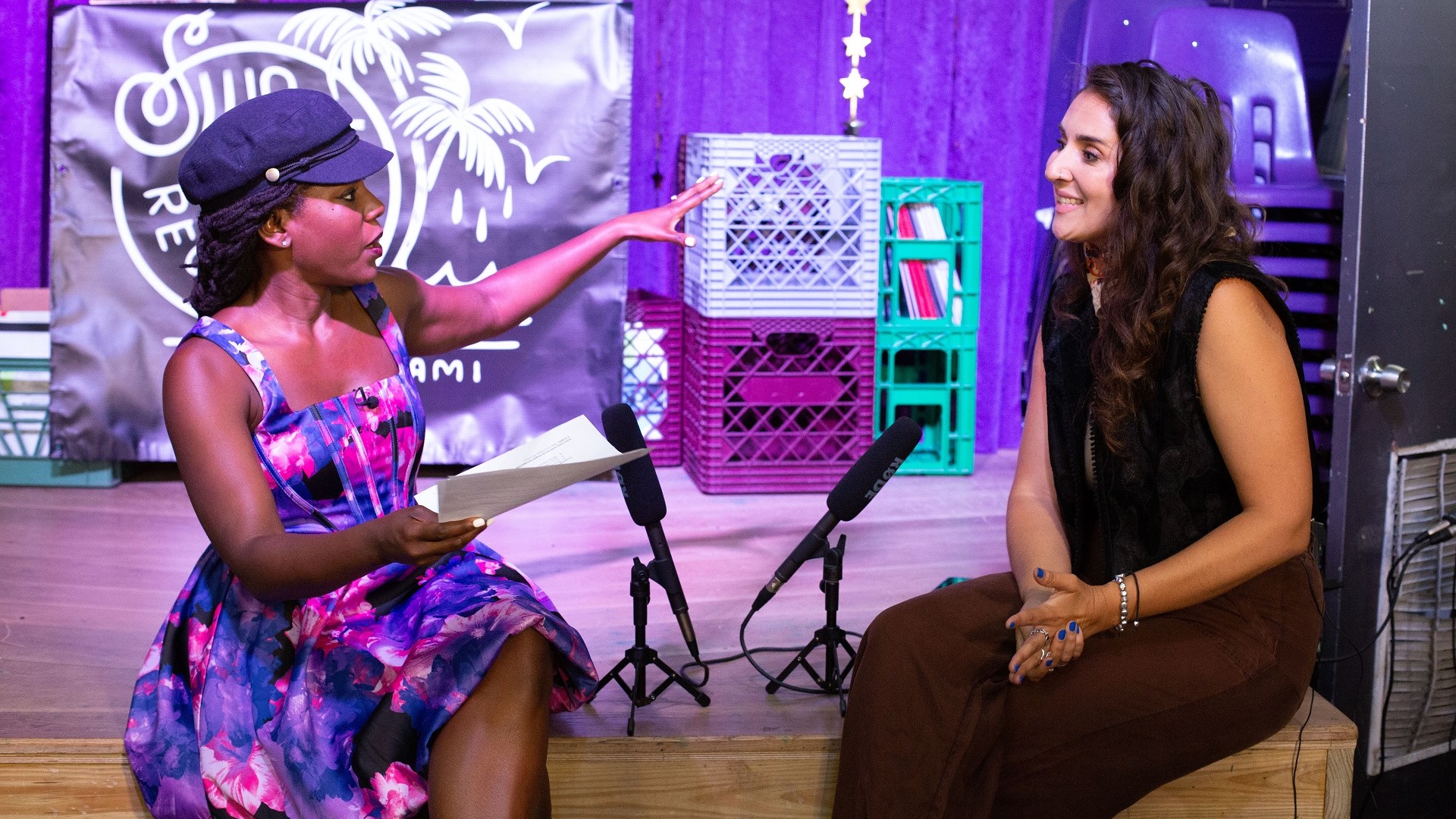
(Illustration: Yeji Kim)
About the JourneySouth Central, Los Angeles: Find the Magic in South LA’s Everyday Moments with a Local Cycling Enthusiast
By Oneika RaymondOneika Raymond dials into South Central, Los Angeles, where local cycling enthusiast Michelle Moro takes us for a tour in her beloved hometown. Born and raised in South Central, Michelle knows her neighborhood inside and out — but she still takes the time to explore like a traveler when she documents her bike rides on her TikTok, @miche1ada.
To showcase the past and present of historic South Central, Michelle hops on her glittery blue bike for a ride up South Central Avenue, one of the longest roads in the city. She begins the tour at the intersection of South Central and East Slauson Avenue, where she quickly points out The Original Snack Shack, a red and yellow stand that’s been serving burgers and fries since 1941.
Michelle’s first stop on the tour is the original site of the Dunbar Hotel, where jazz legends like Billie Holiday and Duke Ellington stayed when they performed next door at Club Alabam between the 1920’s and 1940’s. Today the hotel is a home for elderly community members, though its historic brick facade, lobby, and grand entryway have been preserved in recognition of the Dunbar’s significance to the neighborhood.
Michelle pays tribute to the rich history of the avenue before moving on to grab breakfast at Delicious at the Dunbar, a restaurant serving a mix of soul food and Mexican specialties. From there, she sets off on foot down Central Avenue to take in the community-informed murals being installed by South Central Arts as part of the Green Alleys Network.
While there, Michelle bumps into artist José Cruz and South Central Arts founder Will Flores, who share how the project is both inspired by and reflective of the community that call South Central home.
To end the day, Oneika and Michelle sit down to discuss the benefits of slowing down to really get to know a place and how local organizations are helping Los Angeles visitors and locals alike do just that.
To read full episode transcripts from About the Journey and see photos of each featured destination, head to About the Journey on Marriott Bonvoy Traveler. Starting this season, you can also watch videos from select episodes on our Marriott Bonvoy YouTube channel.
PODCAST TRANSCRIPT
Michelle Moro: All right. You can hear all the super busy sounds of South Central…we’re passing by Granny’s Kitchen and they sell soul food and they’ve been here for a while as well.
Michelle Moro: Something I love about South Central specifically, is that you’ll see a lot of old signs from the forties to the sixties that are still up.
Oneika Raymond: They’ve left it up as a relic of sorts.
Michelle Moro: Yeah, but you’ll also see a lot of the new stuff. Particularly between like 41st and Vernon, so many street vendors.
Michelle Moro: All right. Passing by these little tianguis, those people selling their stuff. These were my stomping grounds growing up, you know? It was my own little 15-minute city.
Oneika Raymond: Welcome to About the Journey. I’m your host, Oneika Raymond, a travel journalist and member of Marriott Bonvoy.
This season, I’m uncovering the lesser known sides of six iconic cities. In my years of travel, I’ve found there is no better way to see a city than through its neighborhoods and the people who call them home. So I’ll be meeting up with in-the-know locals to show me what makes their homes one-of-a-kind: from the sights, sounds and flavors, to the hidden gems, and *so much more.*
This week, we’re in Los Angeles’s historic South Central, embracing the past and present on two wheels.
Will Flores: It’s a loving community here in South Central, full of people that grow together, argue together, (laughs) and, uh, live together.
Michelle Moro: …A resilient neighborhood. It’s the cultural heart of LA jazz, hip hop and corridos.
Maria: You have to take closer looks, you really have to walk around, bike around, to really feel what South Central is.
Oneika Raymond: Ask pretty much anyone, and they’ll tell you Los Angeles is a driving city. It’s famous for its freeways, its convertibles, and its traffic. So when I stumbled on a South Central LA local on TikTok who is lovingly showcasing her neighborhood by bicycle — well, I had to reach out and learn more.
Michelle Moro: My name is Michelle Moro from South Central LA. Whenever I have free time, that is when I’m creating my content and riding my bicycle throughout my neighborhood, you know, showing the world what my neighborhood is like.
Oneika Raymond: Today, Michelle is going to give us a taste of dynamic South Central — by bicycle.
Michelle Moro: We’re about to cross 46th Street, which is where I grew up. All right, so this is where you start seeing the historic South Central part.
Oneika Raymond: After the tour, I’ll call up Michelle for a conversation about how visitors can slow down to get to know her neighborhood.
Michelle Moro: I always recommend for folks to take the Central Avenue corridor ranging from like Washington Boulevard all the way down to Slauson. There is actually historical walking guides that you can see throughout that street and you’ll see how the community is thriving now, and how it’s changed from then to now.
Oneika Raymond: Michelle has been documenting her hometown for years through photography projects and short films. She’s passionate about both sharing the history of South Central as well as uplifting the small businesses that make it what it is today.
But it was a whim that helped bring more awareness to her work.
Michelle Moro: One day, I was just like, I’m just gonna record this, you know, and post it on TikTok and see if people like it, you know?
Oneika Raymond: Michelle was surprised to find that her bike rides around the area struck a chord. But I truly get the appeal: Michelle is an insider sharing everything she loves about South Central. At the same time, she’s also exploring her hometown with the curiosity of a traveler, highlighting locally run coffee shops and sharing updates on new bike and walking paths.
Michelle Moro: Something I always mention in my videos is, you know, the need for coffee shops because you wanna support local businesses. And this is Cafe Calle, right over here. Local LA folks own it and the community loves it. Another place I usually go to is Rooted Cafe, which is not really a cafe, they’re actually a vendor that sells coffee out of their home, but they have a full on coffee bar and they pull really good shots. (Laughs) They’re really good!
Oneika Raymond: In Michelle’s videos, you see her riding down side streets that have a mix of ranches and stucco-ed, bungalow-style homes. In contrast, the main thoroughfares are lined with sky high palm trees, small storefronts, hamburger stands and autobody shops, many of which are marked by carefully hand-painted signs.
Michelle Moro: Like some of them are pretty like kitschy. They’re kind of cute. I love ’em. (Laughs) One of my favorite things, the hand painted signs.
Oneika Raymond: In 2003, the city of Los Angeles designated 28 neighborhoods as the region “South LA.” But many locals still refer to the area south of downtown as South Central, including Michelle.
Michelle Moro: My family has really deep roots here. Where I grew up, right at the corner of that house, my cousin used to have a barbershop. So, we were really just deeply rooted in the community, you know, and we’re still here.
Oneika Raymond: Michelle’s parents moved to South Central from Mexico City in the late eighties. On her social media, Michelle shared old camcorder footage that her father took while driving the same streets she cycles today. The video depicts palm trees, wide streets and families gathering. It looks eerily similar to the present day, save the vintage cars and dated fashion.
It’s a neighborhood that’s been home to a lot of communities over the years, which is reflected in its diversity.
Michelle Moro: South Central was predominantly a Black neighborhood. Eventually started getting a lot of folks moving from Mexico. So you would see a lot of the taco stands pop up, you know, before it became a full LA thing.
But nowadays, you are starting to see a lot of Central American businesses, so now aside from just being able to walk down the corner to get tacos, you can walk down to the corner to get pupusas.
Michelle Moro: So it’s definitely a mix of folks, from Black folks to Latinos, and historically too, there was a large Japanese population, so you’ll still see some of those folks around as well.
Oneika Raymond: Like her father, Michelle is driven to capture momentos cotidianos, or the ‘everyday moments’ of South Central — which is what we’ll get a window into today.
Michelle Moro: All right. Adjusting my helmet. It’s on and tight.
Oneika Raymond: Michelle is joined by a local audio producer named Monica to help capture the sounds of Central Avenue.
Monica: Let’s do a wind test.
Michelle Moro: A wind test. Go down the block?
Monica: Sure.
Michelle Moro: All right.
Oneika Raymond: As she clicks together her bike, Michelle paints a picture of her everyday rider.
Michelle Moro: Um, my bike is actually a folding bike. It’s something that I got inspired by in Japan. when I visited the first time in 2019. I painted it blue, with glitter on it. I actually added two decals, one on each side, and it says “callejera,” which in Spanish means like a person who’s always out and about and never home, so it looks super cute, super glittery.
Sound of bike ringing
Oneika Raymond: Michelle gets on her glittery blue bike and starts her journey. She heads up historic South Central Avenue, one of the longest streets in Los Angeles. She’s starting farther south on the avenue, at the point where it intersects with East Slauson. Right away, she spots a little red and yellow burger stand she has to give a nod to.
Michelle Moro: On our way to Dunbar, we’re passing by the Snack Shack. This is a really important burger joint here in South Central. They’ve been here since 1941, serving burgers and fries. Right now it’s closed, but usually it’s pretty busy with folks lining up for burgers. Anyway, we’re gonna keep going to get to Dunbar…
Oneika Raymond: Michelle makes her way up the busy avenue towards the Dunbar, where South Central’s historic jazz corridor is commemorated. She passes fruit vendors and shops, weaving from the street to the sidewalk.
Michelle Moro: Here you’ll find like thrifted clothes, toys, food. There’s a lady selling chopped fruit and aquas frescas.
Oneika Raymond: The street numbers tick down as Michelle rides north, past Granny’s Kitchen at 55th, which serves soul food, and past 46th, where she grew up. Then she hits Vernon Avenue and Central Avenue, thereby officially entering Historic South Central.
Michelle Moro: All right, and since I’m on the right side I landed here by Jazz Park, which is a very special place to me. You’ll see little ceramic tiles with art that relates to jazz.
Oneika Raymond: Jazz Park is at South Central Ave and 42nd Place — and just across the way is the former home of the Dunbar Hotel, which was once the soul of the Black community’s flourishing jazz corridor in the 1920’s through the 40’s. Michelle stands out front and takes it all in.
Michelle Moro: The Dunbar Hotel on 43rd and Central is where a lot of jazz artists like Billie Holiday, Duke Ellington, Lester Yang, they would stay here when visiting LA. That’s because this was one of the only places specifically Black artists were allowed to stay when they were performing here.
Right next to Dunbar, it used to be Club Alabam, which also had a lot of famous musicians, Ella Fitzgerald, so many, so many different folks.
Oneika Raymond: In 1974, the Dunbar was designated as a Historic-Cultural Landmark by the city of Los Angeles. Today it is no longer a hotel, but an apartment building for elderly community members. In recognition of the Dunbar’s significance to the neighborhood, its historic brick facade, lobby, and grand entryway have been preserved.
On the ground floor is Delicious at the Dunbar, a restaurant serving a mix of soul food like smothered chicken and cornbread and Mexican specialties, like tacos and quesadillas.
Michelle Moro: And usually their portions are pretty big. So, you know, come here with a hungry stomach.
Oneika Raymond: Delicious is bustling, just as it typically is for jazz brunch on Sundays. Michelle sits down to share some coffee and cobbler with our producer Monica.
Monica: Tell me about this peach cobbler.
Michelle Moro: So, you know, it got brought out to us in a small little white cup.Very juicy, full of caramelized sugar and pieces of bread. So delicious.
Jazz music starts up.
Michelle Moro: All right. And now you can hear the band getting ready for jazz.
Oneika Raymond: After taking in some of the music, Michelle heads off to the next stop on the tour.
Michelle Moro: So…right now we’re on our way to 40th Place and Central Avenue, which is where my brother painted a mural and he dedicated it to the community and it’s located at the Montoso, El Montoso market.
Oneika Raymond: Michelle’s brother is an artist who goes by “Brushwork.” He was invited by the minimart to create a mural that wraps around the building. Its hues are predominantly green and yellow, and it is full of imagery that evokes both the past and present of South Central.
Michelle Moro: And you’ll see images of elote, palm trees. You also notice that there’s a image of a farm worker carrying like a costal in the back and he’s carrying elote, tomatoes and it has a house on it. Stands for like, nurturing the neighborhood, making it flourish. You’ll see children, you’ll see basketball, soccer balls again, the fusion of cultures.
Monica: I like how I didn’t really notice downtown, the buildings until the very end. Like that’s the wallpaper.
Michelle Moro: Not the people. Yeah.
Oneika Raymond: Monica’s observation is apt. It’s the people who make the neighborhood what it is today. And cycling has allowed Michelle to slow down and build a deeper connection with her community.
Michelle Moro: When you’re cycling, you can sort of cruise and look to the sides, interact with the folks around you. The way it’s changed my relationship with the neighborhood is that I’m no longer in this like little constrained box, I’m out in the open, listening to the sounds, whether it’s someone listening to the radio, a vendor yelling out, or someone else who’s riding a bike, you know, I, I usually get to interact with those folks…
Michelle Moro: And a little kid just waved at me. I waved back.
Oneika Raymond: Even as she makes her way down South Central Avenue on her two feet, Michelle is bumping into folks left and right.
You hear Michelle bumping into a friend.
Michelle Moro: Hola, cómo estás? Oh my god, Angeles, hola!… Cómo estás?
Oneika Raymond: Michelle decides to swing by the Green Alley Network, where organizations are making side streets more walkable. They are commissioning local artists to create murals that speak to the community there.
Michelle Moro: On the next one, we’re gonna make a left, there’s an alleyway that has a lot of new murals and, um, I think they may still be painting right now…
Oneika Raymond: Michelle wanders over and quickly runs into another of her friends.
Michelle Moro: Hey! I’m doing well, how are you doing, oh my God, to see you too. This is Will Flores. He runs South Central Arts. He’s the one in charge of all of this cool stuff happening here.
Oneika Raymond: South Central Arts is a grassroots network. It elevates the work of artists, entrepreneurs and cultural producers in the region. Will Flores Diaz launched the organization in 2017.
Will Flores: We, uh, utilize all the different art mediums to help empower, you know, all of the local artists that historically were not given the opportunity. Art heals, art helps us communicate. So being part of something that helps create opportunities such as this for my community that I was raised up in is very empowering.
Oneika Raymond: Eleven community inspired murals are being installed here to celebrate the culture of Historic South Central. Artist José Cruz is here too, painting a mural called 41st and Central. He also grew up in the neighborhood, and sees the project as a tribute to his home.
José Cruz: I think it’s one of those things that you won’t really see if you’re traveling in a car, but if you happen to stray off the beaten path, then you’re gonna find some really beautiful art.
Oneika Raymond: It’s notable that not only are the murals created by locals, they’re also informed by the people who live here.
Jose: These are reflecting surveys that the community took. Um, what they wanted to see in their own space, right. The artist then interprets those responses and creates their own piece. It’s been a beautiful experience.
Oneika Raymond: There is a whole lot more to see in South Central. But tagging along with Michelle on her bike, we truly get a sense of the community to be found when we slow down to discover it.
Michelle and I sit down to talk about how visitors can respectfully experience the neighborhood.
Oneika Raymond: I love that you’ve been able to use your platform to not only connect people online, but also educate them about a community that you love and you are passionate about.
Michelle Moro: Thank you…And I also think that, you know, through cycling, walking, you get to find out about a lot of businesses because you get to see some of the like little hidden gems that you may find, you know?
Oneika Raymond: I love that. It’s funny because just as you love to cycle, I love to run. And I think that running is such a great way to get to know, uh, especially a new city for the exact same reasons as cycling because you’re more conscious of everything that’s happening in the street, on the sidewalk.
So, one of your epic bike rides through the neighborhood is actually inspired by a previous, it’s called, CicLAvia.
Michelle Moro: Oh yeah. CicLAvia.
Oneika Raymond: So CicLAvia ride along South Central Avenue. So, what is it exactly?
Michelle Moro: CicLAvia is a nonprofit organization. They work on, you know, making cycling accessible to folks. They host these events every other month where they close down big avenues and they free it up for folks to walk, rollerskate, bike, run…And they also usually promote small businesses that run along those streets.
Oneika Raymond: That’s awesome. Why do you think organizations like this are important?
Michelle Moro: I think that the work that they do is extremely important because by closing down these streets and allowing folks to come in, they can see what the possibilities are and how freeing it is.
Oneika Raymond: If we had a friend right, who was visiting South Central for the first time, where would you want them to visit?
Michelle Moro: One of the places I always take folks would be Alameda Swap Meet. Just because it’s such a cool place it feels like you’re in Mexico, like that was a place that we would go to feel like we’re back home, you know, and you find everything there. They have live music on weekends, they have food. So that’s my top choice. There are so many landmarks here… Thomas Jefferson High School, a high school that had a lot of students who ended up becoming very famous musicians, dancers, athletes, like…The Slauson Super Mall where people get their jewelry and fashion.
Because even going past historic Central Avenue, you’ll see so many cool things. And I would also just advise folks to, you know, come support local businesses and when you are at some of these places, you know, make sure to interact with folks.
Oneika Raymond: Yes!
Michelle Moro: Make sure to, you know, ask how folks are doing or ask about the space if you’re curious about some of the history, you know.
Oneika Raymond: It’s amazing what those little interactions can do…
Michelle Moro: Yeah.
Oneika Raymond: And so I love this idea of being out there on the bike, out in the open air, you’re able to actually go out and engage with real live human beings because that’s what travel is all about.
Michelle Moro: Exactly.
Oneika Raymond: So Michelle, it’s been so amazing talking to you, and you’ve provided us with so many amazing insights about South Central LA. So as a final takeaway, what do you want our listeners to know about South Central LA?
Michelle Moro: Yeah, I think the main thing I want folks to know is that South Central is a beautiful, thriving, melting pot of people just coming together to try and make this place their home and you know, their community.
And yeah, we have a lot of amazing food, a lot of amazing music. Come through, you’ll see that for yourself. (Laughs)
Oneika Raymond: Thank you so much. Not only for all the information that you provided, but also for your enthusiasm. I can tell that you love where you are at and that is such a beautiful thing.
Michelle Moro: Thank you. Thank you. Yes and I do love my hometown. (Laughs)
Oneika Raymond: I’m a firm believer that there is always something new to see and discover and experience, no matter where you are. So I love Michelle’s ethos, that even though South Central is her hometown, she’s still really interested in discovering new things. And as we’ve seen, she’s really able to connect on a deeper level with her community.
I think that if travelers were to adopt this mindset regardless of whether they’re at home or whether they’re abroad or in a new city… we open ourselves up to so many more possibilities.
Oneika Raymond: That’s all for this episode of About the Journey. Thank you to our South Central guide, Michelle Moro. Next week, we’re headed to Miami to experience its Latin music scene.
Isabella Acker: Miami is melting pot, fusion of diversity. Yeah. And so you feel musically that transmits in a set. It’s important to create, I think, bridges of connection. I think that’s what brings people together in a way that like the music speaks for itself.
Oneika Raymond: About the Journey is produced by Marriott Bonvoy Traveler, At Will Media, and me, Oneika Raymond. Our Marriott producers are Robin Bennefield and Valerie Conners. Our AT WILL MEDIA producers are Kait Walsh, Kristy Westgard, Gale Straub and Elliot Davis. Mixing and original theme music by Andrew Holzberger. Additional mixing by Greg Deavens II.
Learn more about Michelle Moro and follow along with her on TikTok @miche1ada. Find out more about South Central Arts at SouthCentralArts.com.
You can learn more about visiting South Central and how to travel more meaningfully — from Marriott Bonvoy Traveler at traveler.marriott.com.
Stay, explore and discover the unexpected with Marriott Bonvoy’s 30 plus hotel brands and over 8000 hotels in cities around the world.
And if you liked this episode of About the Journey, please be sure to rate, review and subscribe wherever you get your podcasts.
I’m your host, Oneika Raymond. See you next time.









